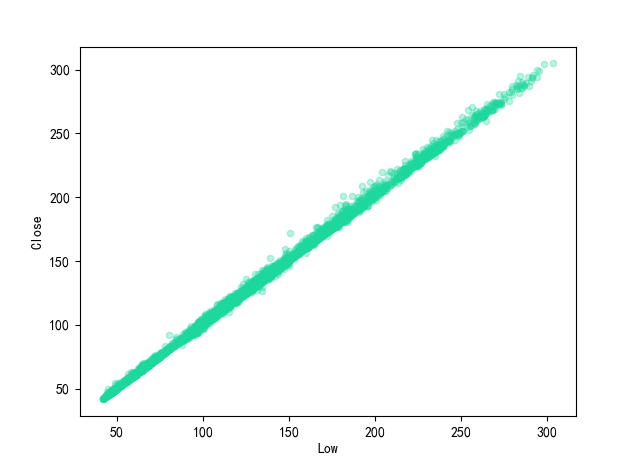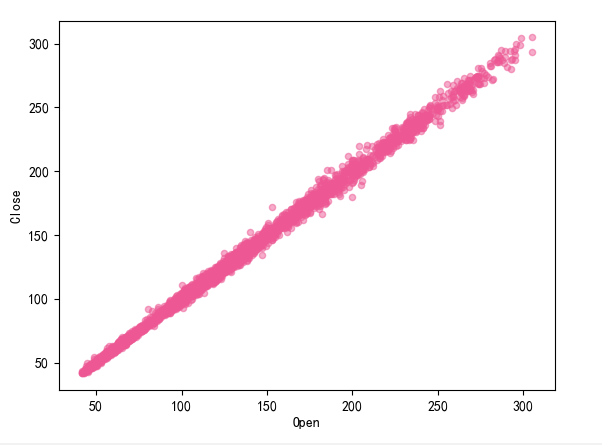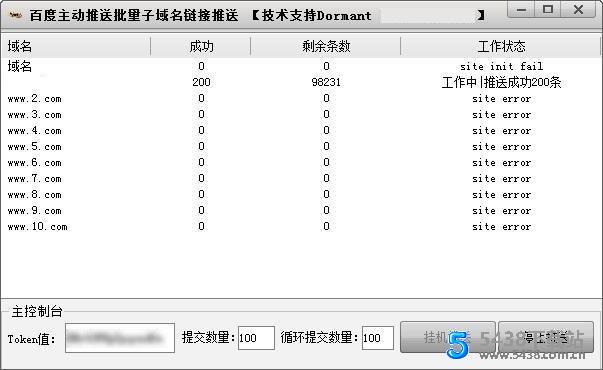一、数据概览
咖啡是一种用烘焙过的咖啡豆、咖啡属某些开花植物的浆果种子调制而成的饮料。 从咖啡果实中分离出种子,生产出一种稳定的、未经烘焙的生咖啡。 然后将种子进行烘焙,这一过程将它们转化为一种可消费的产品:焙烤咖啡,将其磨成细颗粒,通常在热水中浸泡,然后过滤,形成一杯咖啡。
咖啡价格数据从2000年1月2022年5月。
在本例中我们使用pandas、pyplot、seaborn进行数据可视化,绘制折线图、柱状图、散点图,我们可以观察1、日、月、季度、年 咖啡价格,Open-High-Low-Close-Vol每日咖啡价格,Open\High\Low\Close\Vol,Low-Close,High-Close,Open-Close关系。
plt.plot() kind的参数:
- "area"用于面积图。
- "bar"用于垂直条形图。
- "barh"用于水平条形图。
- "box"用于箱形图。
- "hexbin"用于六边形图。
- "hist"用于直方图。
- "kde"用于核密度估计图。
- "density"是"kde"的别名。
- "line"用于折线图。
- "pie"用于饼图。
- "scatter"用于散点图
二、数据预处理
import pandas as pddf = pd.read_csv('./data/coffee.csv')
# df.info()# print(df.shape) # (5671, 7)# print(df.describe())
# print(df.columns) #Index(['Date', 'Open', 'High', 'Low', 'Close', 'Volume', 'Currency'], dtype='object')
# print(len(df.Date.unique())) #5671
# print(df.Currency.unique()) #['USD']三、数据可视化
import pandas as pd
import matplotlib.pyplot as plt
import seaborn as snsplt.rcParams['font.sans-serif'] = ['SimHei'] # 显示中文标签
plt.rcParams['axes.unicode_minus'] = Falsedf = pd.read_csv('./data/coffee.csv')df.Date = pd.to_datetime(df.Date, yearfirst=True)
df.set_index('Date', inplace=True)1、日、月、季度、年 咖啡价格
fig, axes = plt.subplots(2, 2, figsize=[15, 7])
fig.suptitle('咖啡价格', size=24)# 每天的价格
axes[0, 0].plot(df.Close.resample('D').mean())
axes[0, 0].set_title("日", size=16)# 每个月的价格
axes[0, 1].plot(df.Close.resample('M').mean())
axes[0, 1].set_title("月", size=16)
# 每个季度的价格
axes[1, 0].plot(df.Close.resample('Q').mean())
axes[1, 0].set_title('季度', size=16)# 每年的价格
axes[1, 1].plot(df.Close.resample('A').mean())
axes[1, 1].set_title('年', size=16)plt.tight_layout()
plt.show()
2、Open-High-Low-Close-Vol每日咖啡价格
df["Vol"] = df["Volume"] / 100
df["Open"].plot(label="Open", color="#00A505", linewidth=1, figsize=(15, 5))
df["High"].plot(label="High", color="#F54974", linewidth=1, figsize=(15, 5))
df["Low"].plot(label="Low", color="#E8C0FD", linewidth=1, figsize=(15, 5))
df["Close"].plot(label="Close", color="#1CACDB", linewidth=0.75, figsize=(15, 5))
df["Vol"].plot(label="Volume", color="#0000C0", alpha=0.55, linewidth=0.75, figsize=(15, 5))plt.grid(axis="y", color="#000000")
plt.title("Open-High-Low-Close-Vol每日咖啡价格")
plt.xlabel("年")
plt.ylabel("USD")
plt.legend(loc=2)
plt.savefig(r'.\result\Open-High-Low-Close-Vol每日咖啡价格.png')
plt.show()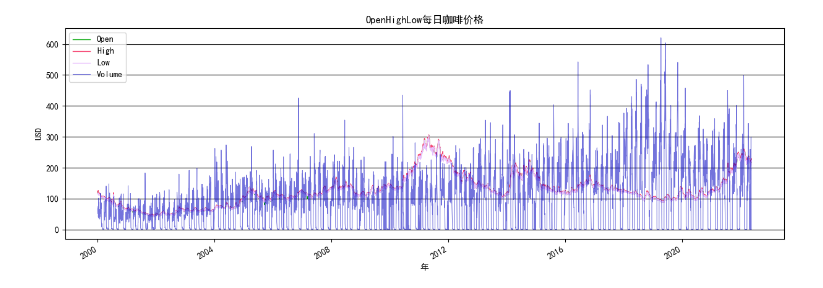
3、Open\High\Low\Close\Vol
def sns_displotbins(df, x, bins):sns.displot(df, x=x, bins=bins)plt.title(x)plt.tight_layout()plt.show()def sns_displot(df, x):sns.displot(df, x=x)plt.title(x)plt.tight_layout()plt.show()sns_displotbins(df, 'Open', 10)
# sns_displotbins(df, 'High', 10)
# sns_displotbins(df, 'Low', 10)
# sns_displotbins(df, 'Close', 10)
# sns_displotbins(df, 'Volume', 10)sns_displot(df, 'Open')
# sns_displot(df, 'High')
# sns_displot(df, 'Low')
# sns_displot(df, 'Close')
# sns_displot(df, 'Volume')
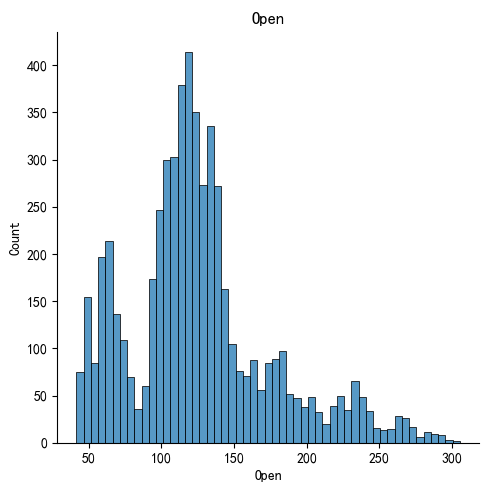
4、Low-Close,High-Close,Open-Close关系
df.plot(x="Low", y="Close", kind="scatter", color="#1CD89D", alpha=0.3) # 散点图
plt.xlabel("Low")
plt.ylabel("Close")
plt.show()df.plot(x="High", y="Close", kind="scatter", color="#0ABF04", alpha=0.5) # 核密度估计图
plt.xlabel("High")
plt.ylabel("Close")
plt.show()df.plot(x="Open", y="Close", kind='scatter', color="#ED5894", alpha=0.5) # 折线图
plt.xlabel("Open")
plt.ylabel("Close")
plt.show()